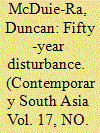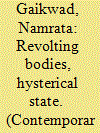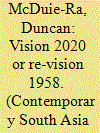|
|
|
Sort Order |
|
|
|
Items / Page
|
|
|
|
|
|
|
| Srl | Item |
| 1 |
ID:
090568


|
|
|
|
|
| Publication |
2009.
|
| Summary/Abstract |
One of the key tools for achieving India's stated ambition of stopping national fragmentation in the Northeast is the Armed Forces (Special Powers) Act (1958) (AFSPA). This article assesses Indian Government efforts to manage the parts of the Indo-Burmese borderlands that are subject to this law. It compares the approaches of governments on the Burmese and Indian sides of the frontier and interrogates the financial incentives that complement security policies in their shared borderlands. Economic incentives for ceasefire and disarmament are, I argue, part of a portfolio of pacification and reintegration strategies that are premised on the controlled ambiguities of the borderlands. As such, I argue that the impunities allegedly at the heart of the AFSPA are matched by the freedom of the Indian Government to funnel resources into paying off its enemies. In the Indian case, the wider environment in which the AFSPA is implemented cannot be ignored if a full analysis of its 50 years of operation is to be offered. The implementation of surrender agreements in the ambiguous space of the Indo-Burmese borderlands exemplifies how the Indian Government has prioritised national cohesion above legal, political or economic consistency.
|
|
|
|
|
|
|
|
|
|
|
|
|
|
|
|
| 2 |
ID:
090564


|
|
|
| 3 |
ID:
090567


|
|
|
|
|
| Publication |
2009.
|
| Summary/Abstract |
Militarisation and structural violence under the Armed Forces Specials Powers Act (AFSPA) is tied to a strong moral framework to proselytise recalcitrant citizens. Deploying Jacque Derrida's point that law is not justice, this paper highlights how the pursuit of justice within the framework of law is a challenging task. Interrogating the contentions around what constitutes 'justice' under the AFSPA, this paper exposes how states legitimise lawlessness through draconian laws like the AFSPA. In this manner, lawlessness is established as a precedent for states to reproduce forms of lawless regimes and undemocratic mechanisms. This paper proposes that along with the campaigns to repeal the AFSPA, we need to reflect upon what kind of justice we seek. Repressive and discriminatory regimes of law, government or practice survive even after they have been formally dismantled. Here, both the state and its citizens negotiate reality regarding the limits of justice in their own way. For the Indian state, it has had to constantly over-extend its coercive powers in order to control the situation. While for its citizens who live under the AFSPA, such a reality is not only a matter of concern but it also redefines their position as citizens/subjects, to the extent that they question the very foundations of democracy,
|
|
|
|
|
|
|
|
|
|
|
|
|
|
|
|
| 4 |
ID:
090570


|
|
|
|
|
| Publication |
2009.
|
| Summary/Abstract |
The Armed Forces Special Powers Act (1958) (AFSPA) has been debilitating for people in Manipur, already struggling with socio-economic and political marginalisation since independence. The consistent erasure of Manipur by an apathetic and forgetful 'mainland' India provides the political impetus for anti-state groups demanding autonomy. The people of the state are, however, ambivalent about taking sides, having experienced the violence engendered by both factions. It is within this complexity that I situate my study of the AFSPA. My paper will elaborate on a theory of haunting, a metaphor I evoke to address this complexity of postcolonial modernity and its silences, by focusing on the protesting icons of the Meira Paibi and Irom Sharmila. Examining the idea of haunting provides us with a vocabulary to push at the limits of rationality that both political movements and social sciences rely upon; haunting, then, is both a methodology and a theme that might help us account for lived realities that are far from rational, clear-cut and thus easy to access. The figure of Sharmila emerges then as one not only haunted by the violence of the postcolonial moment but also simultaneously haunting us - isolated, confined and outlawed, she occupies a liminal position between the living and the dead, enacting a disruption that simply cannot be contained by the modern Indian state or even a rational social science seeking to represent her.
|
|
|
|
|
|
|
|
|
|
|
|
|
|
|
|
| 5 |
ID:
090571


|
|
|
|
|
| Publication |
2009.
|
| Summary/Abstract |
Insurgency in Northeast India has long been explained as an outcome of poverty and isolation that in turn produces further poverty and militancy. In order to break this cycle and achieve 'peace and prosperity', the Indian Government released North Eastern Region Vision 2020 in July 2008 - a comprehensive policy agenda to achieve 'peace and prosperity' in the Northeast. This is to be realised through deeper economic and political engagement with neighbouring countries and a 'paradigm shift in development strategy' that will be simultaneously more participatory and more infrastructure intensive. This paper argues that in practice the political manifestations of increased regional engagement are contradictory. Each measure designed to break the region's isolation is countered by measures to maintain control of borders, trade, and the movement of people. At the heart of this new development vision is a re-visioning of counter-insurgency underpinned by the Armed Forces Special Powers Act (1958). Far from signalling a new era in the region, the measures contained in this new development vision appear more likely to exacerbate the grievances of people in the region and reinforce the ways the region has been governed through five decades of counter-insurgency.
|
|
|
|
|
|
|
|
|
|
|
|
|
|
|
|
|
|
|
|
|